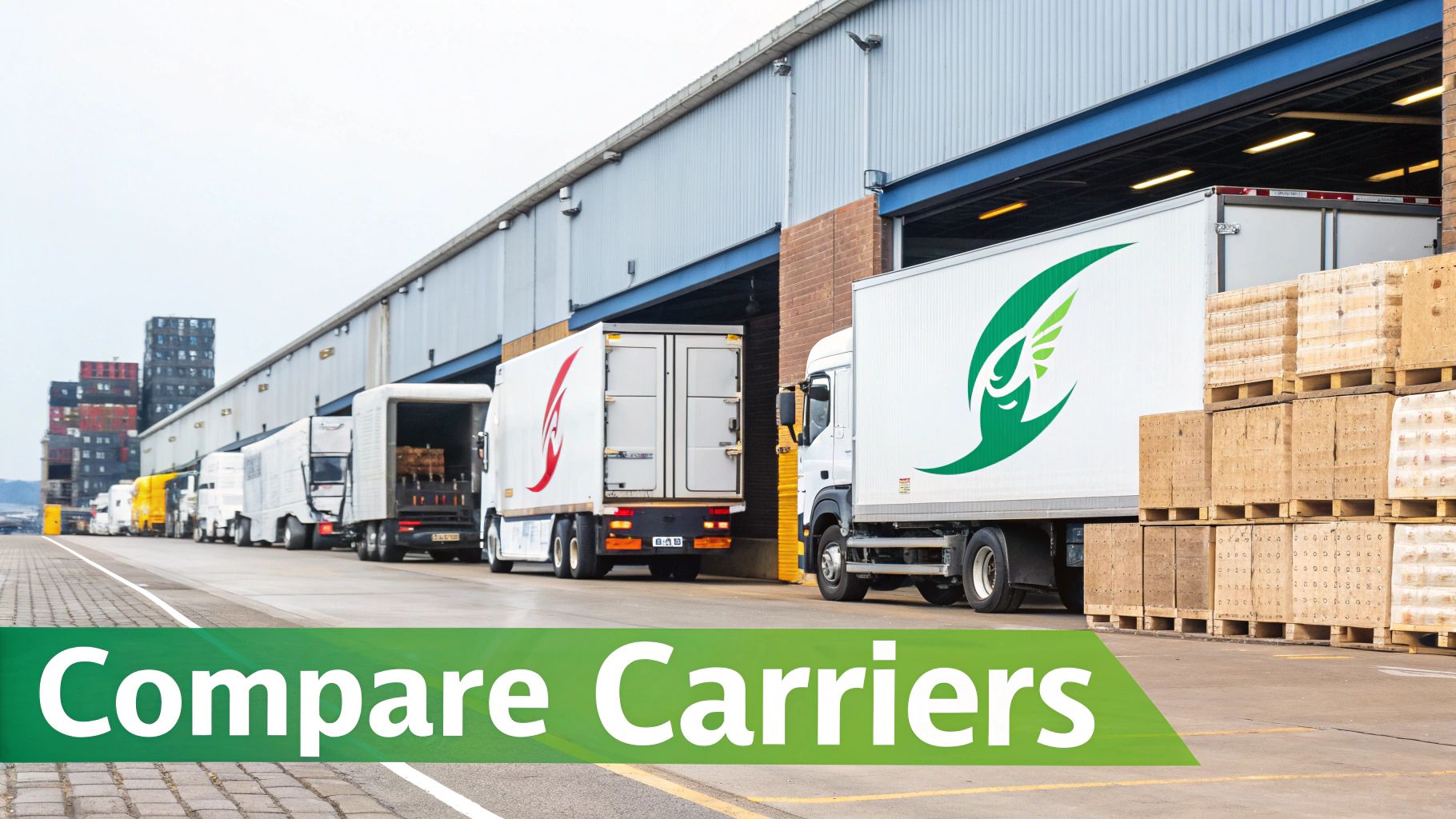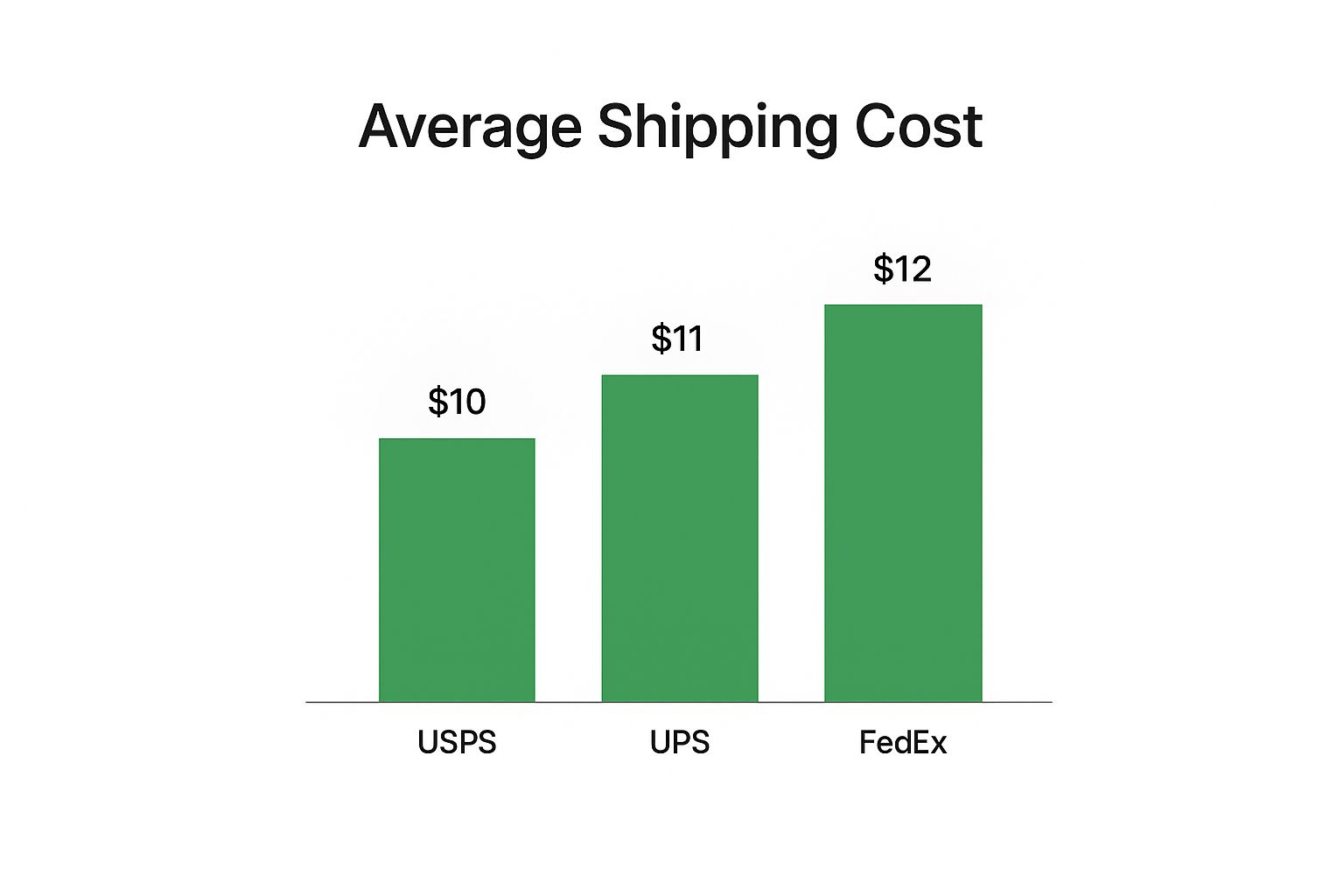Find the Cheapest Way to Ship from the Czech Republic
Karel Maly
August 10, 2025
Figuring out the cheapest way to ship something really boils down to three things: how big it is, how heavy it is, and how quickly it needs to get there. There's no single "cheapest" carrier; the right choice changes with every package.
For parcels staying within the Czech Republic, a local carrier like Česká pošta is almost always your most budget-friendly bet. But if you're bringing in something big and not in a rush, like a container of goods from China, nothing beats the low cost of sea freight.
Getting a Handle on Your Shipping Options
Before you start hunting for discounts, you need to understand what actually drives your shipping costs. It’s not about finding one perfect carrier for everything. It's about matching what you're sending to the best service for that specific job.
Think of it like planning a trip. You wouldn't book a flight to get across town, and you wouldn't try to cycle across Europe for a business meeting tomorrow. Shipping is the same. You're always balancing distance, package size, and delivery speed.
What Really Moves the Price Needle?
-
Domestic vs. International: This is the big one. Shipping within the Czech Republic will always be cheaper. For a local e-shop or just sending a personal parcel, national carriers offer prices that international couriers just can't match. For example, a basic parcel with Czech Post can start from 99 to 119 CZK (around €4 to €5) for typical online orders. You can dig into the specifics of these local delivery methods and their prices online.
-
Size and Weight: Carriers will charge you based on whichever is greater: the actual weight of your package or its dimensional weight (the amount of space it takes up). This is a crucial detail. A big, light box filled with pillows can easily cost more to ship than a small, heavy box of books.
-
Delivery Speed: The faster you need it there, the more it will cost. It's a simple trade-off. Standard ground services are your friend for non-urgent deliveries, while express air freight comes with a premium price tag for its speed.
The biggest mistake I see businesses make is getting comfortable with a single carrier for all their shipments. The carrier that gives you a great deal on small local parcels is rarely the cheapest for a bulky international delivery. Smart shippers are always comparing their options.
Let's say you run a small e-shop out of Prague. For your orders going to customers in Brno, a domestic provider is a no-brainer. But if you need to restock your inventory from a supplier in China, sea freight becomes the only sensible choice, even if it takes weeks to arrive. Mastering this balance between cost, speed, and distance is the first real step to getting your shipping budget under control.
For a clearer picture, here’s a quick breakdown of what you can expect to pay for common shipping scenarios when sending from the Czech Republic.
Quick Shipping Cost Overview for Czech Senders
This table gives a general idea of starting costs. Keep in mind that prices fluctuate based on fuel surcharges, specific carrier deals, and the exact weight and dimensions of your parcel.
| Shipment Type | Typical Starting Cost (CZK) | Best For |
|---|---|---|
| Domestic Small Parcel (under 2 kg) | 99 CZK | E-commerce orders, personal gifts, documents |
| Domestic Medium Parcel (up to 10 kg) | 189 CZK | Larger products, multiple-item orders |
| EU International (to Germany, 2 kg) | 250 CZK | Sending goods to neighbouring EU countries |
| Express International (to USA, 1 kg) | 950 CZK | Urgent documents, high-value small items |
| Sea Freight (LCL from China) | 3,500 CZK+ | Bulk inventory, non-urgent large items |
Ultimately, these figures are just a starting point. Your final cost will always depend on the specifics of your shipment, so getting a direct quote is essential.
A Guide to Domestic Shipping in the Czech Republic

When you're trying to figure out the cheapest way to ship parcels across the Czech Republic, it's easy to get lost comparing the headline prices from carriers like Česká pošta or PPL. But the real secret to cutting costs isn't just about who you ship with; it’s about how you ship. The trick is to perfectly align your package with the carrier’s sweet spot—their most efficient and, therefore, most affordable service.
One of the biggest money-savers right now is the massive network of pickup points, or výdejní místa, that have popped up everywhere. Companies like Zásilkovna have completely built their business around this idea, and for good reason. When you send a parcel to a local shop or locker for the customer to collect, you sidestep the most expensive part of the journey: the "last mile" to their front door. Making this one change can slash your domestic shipping expenses by a surprising 20-40% compared to a standard door-to-door courier.
Matching Your Parcels to Carrier Rules
A common mistake I see businesses make is accidentally racking up surcharges. Every carrier has very specific tiers for weight and dimensions. Go over by just a single centimetre or a few grams, and your parcel can get bumped into a much pricier category. The solution is simple but effective: keep a scale and a measuring tape on your packing station at all times.
It’s just like packing for a low-cost airline. You wouldn't just eyeball your carry-on bag and hope for the best; you measure it carefully to avoid those painful fees at the gate. Apply that same discipline to your parcels.
- Standardise your packaging. Take a look at your most common orders and find the perfect box size for them. This stops you from using overly large boxes that get hit with dimensional weight charges for shipping air.
- Learn the weight breaks. Get to know the key weight thresholds for your main carriers (for instance, up to 2 kg, 5 kg, and 10 kg). If an order is just barely over a limit, you might find it’s actually cheaper to split it into two smaller parcels.
- Choose lightweight fillers. Protect your products with materials like packing paper or air pillows. They do the job just as well as heavier alternatives but without adding unnecessary, costly weight.
Any successful e-shop owner knows the goal isn't just to ship a product. It's to get it into the customer's hands affordably and conveniently. Offering a pickup point option isn't just a smart way for you to save money—it’s a flexible choice that many of your customers will actually prefer.
A Real-World Example from a Prague E-shop
Let's look at a small e-shop in Prague that sells handmade candles. At first, they were using one courier for every order, sending everything door-to-door. Their average shipping cost for a domestic order was floating around 120 CZK. After sitting down and looking at the numbers, they realised this one-size-fits-all approach was costing them a fortune.
So, they made two simple changes. First, they integrated Zásilkovna into their checkout and started encouraging customers to use the pickup point option, which only cost the business 79 CZK per parcel. Second, they designed two standard box sizes that were a perfect fit for their most popular candle orders, making sure they always stayed in the cheapest weight and size category.
The impact was almost immediate. More than 60% of their customers switched to the more convenient and affordable pickup point option. This change, along with their smarter packaging, brought their average shipping cost down to just 95 CZK. It didn't just save them thousands of crowns each month; it also made their customers happier by giving them a better, cheaper delivery option, which is a fantastic way to build loyalty.
Shipping Parcels Across the EU on a Budget

For many Czech businesses and individuals, shipping to other EU countries is a daily task. But finding the most affordable way to send parcels across borders can feel like a maze. While the big international carriers were once the only game in town, the scene has changed dramatically. We're now seeing a wave of specialised cross-border couriers jump into the market, which has sparked some serious competition and, thankfully, pushed prices down.
This new rivalry is fantastic news if you're sending parcels from the Czech Republic. To give you an idea, shipping a package to Poland can now start from around 249 CZK (about €10), and to Germany, you might find rates as low as 229 CZK (€9). These prices aren't a fluke; they're the direct result of postal services getting aggressive to win over the cross-border market. You can see the details behind these lowered prices for EU shipments for yourself.
What does this mean for you? If you’ve been using the same carrier for years out of habit, there's a good chance you're overpaying. The trick is to look beyond the household names and explore these newer, often nimbler services.
How To Find These Lower EU Shipping Rates
Securing the best deal for routes to neighbouring countries like Germany and Poland, or even further afield to Spain, requires a bit of research. Never assume your go-to domestic provider has the best international rates.
Here’s how to uncover those competitive prices:
- Hunt for Specialised Couriers: Look for services that concentrate on Central and Eastern European routes. Companies like Meest Post have built their entire logistics network around these corridors, which is how they can offer such low prices.
- Embrace Price Comparison Tools: Shipping rate aggregators are an absolute must. These platforms do the hard work for you, comparing dozens of carriers in real-time to show you the cheapest option for your parcel’s exact weight, size, and destination.
- Investigate Local Partnerships: It’s not uncommon for a smaller Czech carrier to have a strategic partnership with a major player in another country (like DHL in Germany). This can lead to a surprisingly affordable and seamless door-to-door service.
Even within the EU's single market, documentation matters more than you might realise. While customs duties aren't an issue for most goods, forgetting a commercial invoice or improperly declaring certain items can lead to frustrating delays and unexpected handling fees. Always double-check what's needed.
Don't Let Paperwork Derail Your Savings
Finding a cheap rate is great, but a simple documentation error can wipe out those savings in an instant. Shipping within the EU is far simpler than sending parcels globally, but there are still rules to follow, especially for businesses.
For any commercial shipment, a commercial invoice is typically required, even between EU member states. This document outlines the contents and value of your shipment for tax and record-keeping. If you forget it, your parcel could get stuck in a sorting facility until the paperwork is sorted, causing delays and potentially racking up administrative fees.
Similarly, sending restricted items—think alcohol, tobacco, or certain electronics—involves specific rules and requires careful declaration. Taking a few extra minutes to get your documentation right is one of the smartest things you can do to ensure your delivery is on time and on budget. For more insights on streamlining your entire shipping process, check out our guide on last-mile delivery solutions in the Czech Republic.
Finding the Cheapest Global Shipping Options
When your products have to cross oceans, the price difference between shipping methods can be absolutely massive. Figuring out the cheapest way to ship internationally isn't just about picking a carrier; it's a careful balancing act between speed and price. For a business in the Czech Republic bringing in goods from a manufacturing powerhouse like China, this decision directly impacts everything from delivery schedules to profit margins.
At the heart of it, you're usually choosing between two main players: sea freight and air freight. They serve completely different purposes. Think of air freight as the sprinter—incredibly fast and direct, but you pay a premium for that speed. Sea freight, on the other hand, is the marathon runner. It's slow and steady, but for big, non-urgent shipments, its cost-effectiveness is simply unbeatable. If you have the time to wait, the ocean is almost always your most economical route.
This chart gives you a sense of the cost differences between major carriers for standard parcels. While international freight operates on a much larger scale, the core principle is the same.

Even though these are domestic parcel figures, the lesson is clear: even seemingly small pricing differences between carriers can add up to huge sums over time, especially with bulk shipments.
Sea vs Air: A Real-World Comparison
Let's put this into perspective. Imagine you run an e-shop in Prague and you've just ordered a new collection of home decor items from a supplier in Guangdong. The order is big enough to fill a small container, but you don't need it on your shelves next week.
In a situation like this, sea freight is the hands-down winner for saving money. While the specifics can vary, you can learn more about the latest China-to-Czech shipping costs to see how the numbers typically break down for your own planning.
To really see the difference, let’s look at the two options side-by-side.
A comparison of the primary international shipping methods from China to the Czech Republic reveals stark trade-offs between cost, speed, and overall suitability.
International Shipping Method Comparison (China to CZ)
| Method | Estimated Cost | Transit Time | Best For |
|---|---|---|---|
| Sea Freight | $40 - $150 per CBM | 30 - 50 days | Large, heavy, or non-urgent bulk shipments. The most cost-effective option. |
| Air Freight | $5 - $15 per kg | 5 - 10 days | Urgent, high-value, or lightweight goods where speed is the top priority. |
| Rail Freight | Varies widely | 15 - 25 days | A balanced choice for goods needing to arrive faster than by sea but at a lower cost than by air. |
As the table shows, there’s no single "best" method—it all comes down to your specific needs for that particular shipment.
The patience required for sea freight pays off directly on your bottom line. An extra month of transit time can mean thousands of dollars saved, which you can reinvest into your business or pass on as savings to your customers.
For most businesses I've worked with, this waiting period is a manageable and predictable part of their inventory planning cycle. You just have to build it into your timeline.
Don't Overlook Rail Freight
There's a third option that often gets forgotten but provides a fantastic middle ground: rail freight. For shipments moving across the vast Eurasian landmass, like from China to Europe, rail is a surprisingly practical choice.
It’s significantly faster than sea freight, usually taking around 15 to 25 days, yet it's considerably cheaper than air freight. This gives you a brilliant balance if you need your goods faster than a container ship can get them there but just can't stomach the high cost of flying them.
Partnering with a Freight Forwarder
Trying to sort out international logistics by yourself is not only a headache but often ends up being more expensive. A freight forwarder is your expert ally in this game. They essentially act as your agent, using their deep industry relationships and massive shipping volumes to negotiate far better rates with sea, air, and rail carriers than you could ever secure on your own.
A top-notch freight forwarder does more than just find good prices. They handle the labyrinth of documentation, customs clearance, and insurance, shielding you from hidden fees and disastrous delays. If you're serious about finding the genuinely cheapest and most reliable way to ship globally, a freight forwarder isn't a luxury—it's an essential partner.
How Smart Packaging Reduces Your Shipping Bill
 It's easy to overlook, but your choice of box and packing materials has a huge impact on your final shipping bill. So many businesses make the same costly mistake: they focus only on the actual weight of a parcel. They completely forget that carriers often charge based on dimensional weight (DIM weight), which is all about the size of the package.
It's easy to overlook, but your choice of box and packing materials has a huge impact on your final shipping bill. So many businesses make the same costly mistake: they focus only on the actual weight of a parcel. They completely forget that carriers often charge based on dimensional weight (DIM weight), which is all about the size of the package.
What this means in practice is that a large, mostly empty box can cost you a lot more to send than a smaller, denser one, even if the smaller one is heavier. If you want to find the cheapest way to ship, you have to get good at efficient packaging. It's a non-negotiable skill.
Understanding and Beating Dimensional Weight
So why do carriers bother with DIM weight? It's simple, really. Space on a delivery truck or plane is a finite, valuable resource. A big, light parcel still eats up a lot of room that could have been used for more packages. By charging for the volume a box takes up, carriers make sure every centimetre of their transport space is generating revenue.
Your job is to make your parcel take up as little space as possible. Always aim for a box that's just big enough for your item plus a sensible amount of protective cushioning. Don't just grab a standard large box for a small item – you’re literally paying to ship air.
I've seen businesses slash their shipping bills by over 15% just by auditing their box sizes and eliminating oversized packaging. It’s one of the simplest yet most effective cost-cutting measures you can implement immediately.
Practical Steps for Smarter Packaging
Fine-tuning your packaging process doesn't have to be a massive project. It really just comes down to making a few smart choices that add up to significant savings over time.
Here are a few things you can start doing right away:
- Select Lightweight Void Fill: Ditch heavy packing materials and switch to lighter alternatives. Air pillows or even just crumpled packing paper provide fantastic protection for most items without adding those extra grams that can bump you into a more expensive shipping tier.
- Consolidate Shipments: If a customer orders multiple items, always try to combine them into one, well-sized box. Sending a single larger parcel is almost always cheaper than shipping two or three separate small ones.
- Measure Everything: Keep a measuring tape and a digital scale right there at your packing station. Before you tape up a box, get its dimensions and weight. This lets you confirm it falls into the most cost-effective tier with your carrier before it leaves your hands.
Beyond just the materials, the way you pack your items can make a real difference to both cost and safety. Learning proper techniques for packing boxes for shipping helps prevent damage and avoid surprise fees. These smarter habits don't just lower your direct costs; they also contribute to a more sustainable operation. To learn more, check out our guide on understanding the carbon impact of shipping and logistics.
Unpacking Common Questions About Shipping in the Czech Republic
Even with a solid plan, a few practical questions always pop up when you're trying to nail down the cheapest way to ship parcels from the Czech Republic. Let's tackle some of the most common ones I hear from businesses trying to solve their own shipping puzzles.
What's Genuinely the Cheapest Carrier for Small Domestic Parcels?
If you're just looking at the price tag for a small parcel within Czechia, Česká pošta (Czech Post) is often the go-to for rock-bottom costs. Their massive network and no-frills standard services are built for pure economy on a local level. It’s the traditional, straightforward option.
But "cheap" isn't just about the price anymore. If you factor in customer convenience, a service like Zásilkovna often delivers much better overall value. Shipping to one of their thousands of pickup points (výdejní místa) can be just as cheap—sometimes even cheaper—than a standard home delivery. Plus, you're giving your customers a flexible collection option they've come to expect.
My advice? Don't just chase the lowest number on a price list. Think about the experience. The slight cost of offering a pickup point is often repaid in customer loyalty, as a huge chunk of Czech shoppers now actively prefer it.
So, the real takeaway is this: check Czech Post for basic door-to-door affordability, but always compare it against Zásilkovna for a low-cost, modern alternative that your customers will thank you for.
How Do I Find the Absolute Lowest Rates for EU Shipping?
When you're shipping to other EU countries, especially neighbours like Germany, Poland, or Austria, you have to think beyond the usual domestic names. Finding the best price isn't about luck; it's about a smart, repeatable strategy.
Here's what works:
- Embrace Price Comparison Tools: Shipping aggregators are non-negotiable for cross-border shipping. These platforms do the heavy lifting, comparing dozens of couriers in real-time to find the cheapest carrier for your parcel's exact weight and destination. It’s the fastest way to uncover options you didn't even know you had.
- Hunt for Regional Experts: Look for couriers that have carved out a niche in Central and Eastern European routes. Companies like Meest Post, for example, have incredibly efficient networks for these specific corridors. This specialisation allows them to offer prices that the big global players simply can't compete with.
- Get Your Paperwork Right: This one trips people up all the time. Even though it's the EU, a missing or incorrect commercial invoice can lead to frustrating delays and extra handling fees, wiping out any savings you found. Double-check your documentation on every single shipment.
By actively comparing prices and seeking out these regional specialists, you can consistently find EU shipping rates that are miles better than the standard offers.
Are Shipping Rate Aggregators Actually Worth the Bother?
Yes, one hundred percent. Using a shipping rate comparison tool is probably the single most effective, time-saving tactic you can implement. Think about it: instead of opening six different browser tabs and manually entering package details to get quotes, an aggregator does it all for you in a matter of seconds.
For any business shipping more than a couple of packages a day, the time saved alone is a huge win. But the real magic is in the money they save you. These tools often find promotional rates or highlight smaller, efficient carriers you've never heard of, consistently digging up the cheapest way to ship for any given package.
Just a few moments spent on an aggregator can easily lead to savings of 10-30% on your annual shipping bill. And remember, logistics isn't just about cost—it's also about smart compliance. Choosing efficient carriers is a big part of that, a topic we explore further in our guide on carbon tracking and regulatory compliance in the Czech Republic.
Ready to stop guessing and turn your shipping from a necessary expense into a real competitive edge? Carbonpunk uses powerful AI to dive deep into your shipping data, pinpointing where you're overspending and providing clear, actionable steps to lower both your costs and your carbon footprint. Find out how Carbonpunk can sharpen your logistics strategy today.